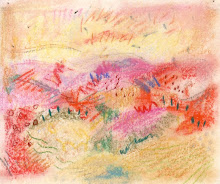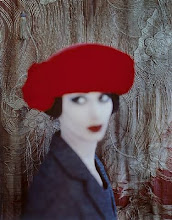Saturday, 26 June 2010
Wednesday, 23 June 2010
Queen Nefertiti wore eyeliner
Above : Queen Nefertiti wore eyeliner
Here, I've redeveloped a Sony Reader drawing into a mixed media painting (acrylic ink, watercolour crayons, colour crayons, Caran d'Ache Neocolour II water-soluble wax crayons).
13cm x 16.5cm
June 2010
Tuesday, 22 June 2010
For Dorothea : The black poet and the Dutch painter
Last night I attended an evening of poetry readings hosted by the Magma magazine at The Troubadour in London. Amongst the guest poets was Dorothea Smartt: a British born poet of Barbadian heritage whose work is gaining a lot of recognition. There is a special feature about Dorothea in the current issue of Magma. The article includes a photograph of Dorothea by photographer Robert Taylor. The portrait reminded me of Vermeer's Girl with a Pearl Earring (below), I suppose because of the sideways glance, the partial shading of the face and the head scarf. The photograph also speaks of Dorothea's strong personality and prompted me to do the drawing above with my Sony Reader. I'd like to develop the drawing into a painting... watch this space !
Vermeer : Girl with the Pearl Earring
If you'd like to know more about Dorothea Smartt, go to :
http://www.britbornbajan.com/
Monday, 21 June 2010
Friday, 18 June 2010
Wednesday, 16 June 2010
The girl in the picture

(Above) I saw an African Queen
9cm x 12.5cm
March 2010
Having had a colour postcard produced of this painting (which is actually just a little smaller than the postcard), I am now being asked "who is she?" "Who is the girl in the picture?"
Like much of my work, this painting started as a Sony Reader drawing/study (see below) after a fashion photograph (further below) that I happened to see whilst browsing on the Internet. I had recently been given the Reader as a present and I was experimenting with the Handwriting app, learning how to use it as a drawing tool. I was struck by the photograph because of the model's very penetrating gaze. It's a gaze that recalls the impenetrable look that many of Manet's models have, for example in Olympia and Dejeuner sur l'herbe. It's a gaze that engages with the viewer directly and creates equivalence between the subject and the object.
The title, again as many of the titles I create for my works, offers another layer of meaning, pointing as it does to the idea of perception. I saw the photograph of Tiguida Sissoko (who I now know to be a Malian/Nigerian supermodel) by chance. Not knowing at that stage anything about the sitter, my interpretation of the photograph was shaped by my impressions and perception: I saw an African Queen. Paintings are after all a representation of the artist's perceptions, which are shaped and moulded by their life and cultural experiences (you readily see, or remember seeing, what you are able to "recognize"). Now of course we live in a "media-tized" world and we carry with us, consciously or subconsciously, a plethora of images that in turn affect how we perceive the world around us. Much of my work is a comment on this experience, in particular on the presence in our collective psyche of the ubiquitous female face that has always and continues to dominate our culture's iconography. Where in the past we might have seen visual representations of mythic deities or saints and martyrs, we now see icons of (amongst others) fashion and beauty.
Of course, I am not the first to be intrigued by the gaze and the role it plays in our culture. There are precedents in art history and amongst other contemporary artists. The celebrity and fashionable portraits of Elizabeth Peyton come to mind as do the celebrity portraits of the American artist Karen Klimnik. In June 2000 the art critic Johnathan Jones wrote about Klimnik (with particular reference to her portrait of the British actor Hugh Grant) in the Guardian:
"This is a nice example of a relatively new genre of painting, which we might call the iconic portrait, not commissioned by its sitter but based on photographs, magazine cuttings, film clips. The painter puts a famous face on canvas, translating the voyeuristic look we fix on celebrity into art. Its history can be tracked through the 19th and early 20th centuries in painters like Degas and Sickert, who painted royalty glimpsed in the street and copied their faces from photographs. Later in the 20th century royalty mutated into celebrity and the most famous exponent of the iconic portrait was Andy Warhol, who helped to shape fame as we know it."
Regards my work, I should say that whilst I readily work from photographs and other images that are in the public domain, I tend to use less identifiable faces or faces that are "known" but not so easily named. I'm not so much concerned with the sitter's "celebrity" status and more intrigued by what makes a face "iconic". The title of this blog brings this aspect of the famous face to mind. The phrase is usually associated with one of two iconic photographic images of the 20th century : the photograph by Nick Ut of "the little girl" (Kim Phuc) running naked from her village in Vietnam after being badly burnt in a napalm attack, and the the National Geographic colour photograph by Steve McCurry of "the Afghan girl" (Sharbat Gula), which is, apparently, now the most "recognisable" image in the world. Although I've given their names, for all intents and purposes "the girl[s] in the picture" (of course, they are now women) are anonymous, but their images, like those of the courtesan who posed naked for Manet, have now been immortalised in the collective conscience.
Below: A Sony Reader drawing after a fashion photograph (further below) of the supermodel Tiguida Sissoko. The photograph seems to be quite widely referenced on the Internet but I can't credit the photographer as he/she is not identified, at least not by any of the sites where I've seen this photograph. If you know, let me know and I'll correct this omission.


Tuesday, 15 June 2010
Monday, 14 June 2010
Mr Parkinson's Hat
(Above) Mr Parkinson's Hat
June 2010
15cm x 17.5cm
This mixed media painting on paper started as a study with my Sony Reader of a Vogue cover by the photographer Norman Parkinson (see yesterday's post) who obviously enjoys the paintings of Kees van Dongen.
After a lot of red and orange paintings recently, I felt in the need to get my blue and green inks and crayons out.
Sunday, 13 June 2010
Celia
Celia
Mixed media on paper
June 2010
17cm x 21 cm
This painting was developed from one of my Sony Reader drawings: a study that I did in response to one of David Hockney's portraits of Celia Birtwell.
As with many of my paintings of this type, I hesitate to call this a "portrait" as I have never met Celia Birtwell. The image is a representation of my perception of her based on the images: drawings, paintings (mostly by Hockney) and photographs, that I've seen of her in books and now on the Internet.
(Above) Detail of a drawing by David Hockney of Celia Birtwell
Of all these images what I retain is a vision of a woman with fair, almost porcelain skin, reddish-blonde hair, green eye-shadow, dark eye-liner, and a very feminine line. My "portrait" is based on this perception. How close that is to "reality", I don't know, and of course that's not the point here.
Whilst I was looking at the drawings by Hockney I was also looking at some of the photographs by Norman Parkinson for Vogue. I enjoy the way he often uses a bright palette of limited colours, as in this cover: Thursday, 10 June 2010
The Painter's Wife
Here, I've reworked one of my Sony Reader drawings/studies in mixed media on paper.
A Google image search can yield loads of portraits, from all eras, of "The Painter's Wife". One of my favourite paintings of this type is a portrait by Roaul Dufy (below) of his wife who he has painted sitting at a table with a brightly covered cloth against a brilliant blue ground. The original painting is in the Musée des beaux arts, Nice.
Tuesday, 8 June 2010
The strange woman on page 366
(Above) The Strange Woman on Page 366
14.5cm x 14.5cm
June 2010
I've developed this painting (in mixed media on paper: a variety of inks, watercolour crayons and water-soluble wax crayons) from a Sony Reader drawing/study that I've done of a painting that I saw in a book on Picasso (page 366) borrowed from the local library.
Our perception of ourselves as human beings is in part shaped by... our perceptions of ourselves as human beings: by images created, shared and handed around and down by artists, painters, sculptors, photographers; images which reside in our subconscious, memories and imaginations from where they inevitably colour our subsequent visions of the world.
Sunday, 6 June 2010
The Handsome Painter
Saturday, 5 June 2010
She wanted to be a living work of art: SOLD!

She wanted to be a living work of art
12.65cm x 16.73cm
June 2010
As with many of my paintings, this portrait (predominently indian ink on paper but there's a little bit of water colour crayon and wax crayon) was developed from an image found in the media (a photograph of the eccentric Italian heiress and fashion icon "Casati"). It started as a Sony Reader drawing-study, which I have reworked in mixed media on paper. More than a portrait, the painting is a representation of the ubiquitous female face that continues to dominate our culture's iconography. Casati was never afraid of the camera or the artist and always appropriated the gaze, engaging the viewer directly, creating equivalence between the viewer and the viewed, challenging the distinction between the subject and the object. Simply put: she's looking at us looking at her.
Tuesday, 1 June 2010
La femme du peintre: SOLD!

La femme du peintre
A painting developed from an original Sony Reader drawing reworked in mixed media (inks and wax crayons) on paper.
17cm x 21cm
June 2010
Always very colourful, my paintings celebrate the female face. Often they are informed by photography or other imagery such as sculpture and paintings that I enjoy (see my other blog "The Art of Gazing" http://hannahonart.blogspot.com/ ). This painting for example began as a drawing-study produced using the Handwriting function of the Sony Reader of a portrait by Pascin. I rework these electronic drawings to create images on paper that are full of colour and life and (perhaps for this reason) sensual. My paintings are also sometimes a little quirky: the sitters often strike a sideways regard that directly engages the viewer’s gaze; inviting the viewer to gaze at the gazed.
Subscribe to:
Comments (Atom)









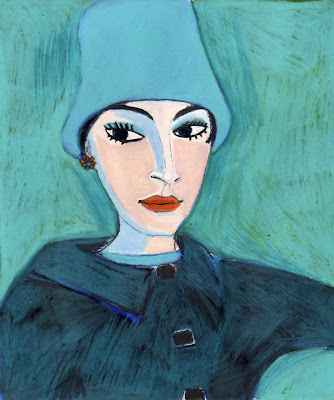






.jpg)



























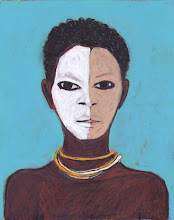
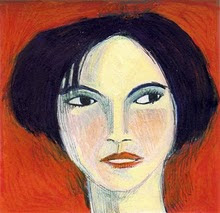
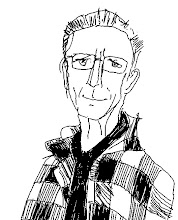



.jpg)








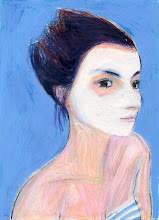








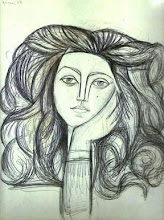

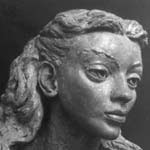




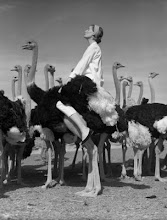
.jpg)

